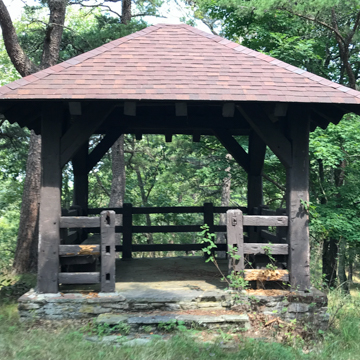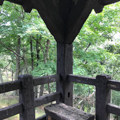Looking out through the forest and surrounding hills, the Covey Cove Trail Shelter, built by the Civilian Conservation Corps (CCC), is the only one of the six in Lost River State Park with a hipped roof, which offers greater covering from the elements than the other shelters. This may be due to the fact that it received more use, since it is located closer to the cabins and is accessible via a relatively easy hike. The other trail shelters in the park feature a saltbox roof. Currently, the Covey Cove Shelter’s roof is covered with terra-cotta-colored asphalt shingles. The structure is composed of four squared log posts with mortise and tenon joints and corner braces. The shelter rests upon a raised stone pad and the railed sides feature three horizontal slats, with an opening on the entry side.
References
Gioulis, Michael. New Deal Historic Resource Survey. Charleston: West Virginia Division of Culture and History, Charleston, 2008.
Sweeten, Lena L., “New Deal Resources in West Virginia State Parks and State Forests,” West Virginia. National Register of Historic Places Multiple Property Documentation Form, 2010. National Park Service, U.S. Department of the Interior, Washington, D.C.
West Virginia State Park History Committee. Where People and Nature Meet: A History of the West Virginia State Parks. Charleston, WV: Pictorial Histories Publishing Company, 1988.








